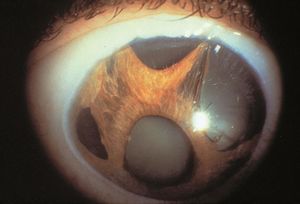Congenital corectopia iridodialysis is a rare eye condition that affects the iris and its attachment to the ciliary body. It is characterized by a displacement or abnormal positioning of the iris and a separation or detachment of the iris from its attachment to the ciliary body.
The exact cause of congenital corectopia iridodialysis is unknown, but it is believed to be a genetic condition. It is usually present at birth or develops in early childhood. The condition may be associated with other ocular abnormalities, such as glaucoma, cataracts, or coloboma.
The most common symptoms of congenital corectopia iridodialysis are changes in the shape and position of the pupil. The pupil may be irregularly shaped or off-center, and it may appear elongated or oval in shape. Other symptoms may include blurred or distorted vision, sensitivity to light, and eye pain or discomfort.
Congenital corectopia iridodialysis is typically diagnosed during a comprehensive eye exam. An eye doctor will examine the iris and ciliary body using a slit lamp, a specialized microscope that allows them to visualize the structures of the eye in detail. Additional tests, such as ultrasound or optical coherence tomography (OCT), may also be performed to assess the structure and integrity of the eye.
Treatment for congenital corectopia iridodialysis is focused on managing the symptoms and complications associated with the condition. Treatment options may include:
- Corrective lenses: Prescription glasses or contact lenses may help improve vision by correcting refractive errors, such as nearsightedness or astigmatism.
- Surgery: In severe cases, surgery may be necessary to repair the detachment of the iris and reattach it to the ciliary body.
- Glaucoma treatment: If the condition is associated with glaucoma, treatment may include medications, laser therapy, or surgery to lower intraocular pressure and prevent further damage to the optic nerve.
The prognosis for congenital corectopia iridodialysis varies depending on the severity of the condition and the associated symptoms. In some cases, the abnormal positioning of the iris may not cause significant vision impairment or complications. However, in more severe cases, the condition may be associated with glaucoma, cataracts, or other ocular abnormalities, which can lead to permanent vision loss if left untreated.
To summarize, Congenital corectopia iridodialysis is a rare eye condition that affects the iris and its attachment to the ciliary body. It is characterized by a displacement or abnormal positioning of the iris and a separation or detachment of the iris from its attachment to the ciliary body. While there is no cure for the condition, there are several treatment options available to manage the symptoms and complications associated with the condition. If you or a loved one has been diagnosed with congenital corectopia iridodialysis, it is important to work closely with an eye doctor to develop an appropriate treatment plan and monitor the condition over time.
At The Eye Center- Dr. Mahnaz Naveed Shah & Associates our team of eight ophthalmology subspecialists/ eye specialists, eye surgeons who are considered amongst the very best eye specialists in Karachi and in Pakistan, have the diagnostic and treatment capabilities to treat from the simplest to the most complex patients. We work hard to provide our patients with the best possible medical and surgical eye care, in a state of the art purpose built eye care facility. We offer the entire array of medical, laser and surgical treatments to help provide patients the best possible care in the most efficient, safe and ethical manner.
If you need an appointment, please contact us at 03041119544 during our working hours or leave us a WhatsApp message at +923028291799 and someone will connect with you. Walk-in appointments are also available for emergencies. We can also be reached through our web portal on www.surgicaleyecenter.org


